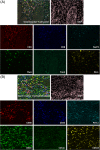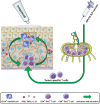A pre-existing coordinated inflammatory microenvironment is associated with complete response of vulvar high-grade squamous intraepithelial lesions to different forms of immunotherapy
- PMID: 32574376
- PMCID: PMC7540004
- DOI: 10.1002/ijc.33168
A pre-existing coordinated inflammatory microenvironment is associated with complete response of vulvar high-grade squamous intraepithelial lesions to different forms of immunotherapy
Abstract
Immunotherapy of vulvar high-grade squamous intraepithelial lesion (vHSIL) is investigated as an alternative for surgery, because of high comorbidity and risk of recurrence. Limited evidence exists on the role and composition of the immune microenvironment in current immunotherapeutic approaches for vHSIL. The vHSIL of 29 patients biopsied before treatment with imiquimod were analyzed by two multiplex seven-color immunofluorescence panels to investigate the pre-existing T-cell and myeloid cell composition in relation to treatment response. The samples were scanned with the Vectra multispectral imaging system. Cells were automatically phenotyped and counted with inForm advanced image analysis software. Cell counts and composition were compared to that of vHSIL patients before therapeutic vaccination (n = 29) and to healthy vulva (n = 27). Our data show that the immune microenvironment of complete responders (CR) to imiquimod resembled the coordinated infiltration with type 1 CD4+ and CD8+ T cells and CD14+ inflammatory myeloid cells also found in healthy vulva. However, more CD8+ T cells and FoxP3+ regulatory T cells were present in CR. The lesions of partial responders (PR) lacked such a coordinated response and displayed an impaired influx of CD14+ inflammatory myeloid cells. Importantly, complete responses after imiquimod or therapeutic vaccination showed the same dependency on a pre-existing coordinated type 1 T-cell and CD14+ myeloid cell infiltration. In conclusion, a good clinical outcome after two different forms of immunotherapy for vHSIL is associated with the presence of a primary inflammatory process resulting in the coordinated influx of several types of immune cells which is then amplified.
Keywords: TLR7; imiquimod; immune microenvironment; therapeutic vaccine; vulvar HSIL.
© 2020 The Authors. International Journal of Cancer published by John Wiley & Sons Ltd on behalf of UICC.
Conflict of interest statement
The authors declare no potential conflict of interest.
Figures





References
-
- van Seters M, van Beurden M, ten Kate FJ, et al. Treatment of vulvar intraepithelial neoplasia with topical imiquimod. N Engl J Med. 2008;358:1465‐1473. - PubMed
-
- van Poelgeest MI, Welters MJ, Vermeij R, et al. Vaccination against Oncoproteins of HPV16 for noninvasive vulvar/vaginal lesions: lesion clearance is related to the strength of the T‐cell response. Clin Cancer Res. 2016;22:2342‐2350. - PubMed
-
- Stanley MA. Imiquimod and the imidazoquinolones: mechanism of action and therapeutic potential. Clin Exp Dermatol. 2002;27:571‐577. - PubMed
-
- Schon MP, Schon M. Imiquimod: mode of action. Br J Dermatol. 2007;157(Suppl 2):8‐13. - PubMed
Publication types
MeSH terms
Substances
LinkOut - more resources
Full Text Sources
Other Literature Sources
Medical
Research Materials

